HNBS 337 Case Study: Analyzing B2C & B2B Consumer Decision-Making
VerifiedAdded on 2022/11/25
|10
|2818
|406
Case Study
AI Summary
This case study examines consumer behavior in both B2C and B2B contexts, focusing on the consumer decision-making process. It details the various phases of customer decision-making, from need recognition to post-purchase evaluation, and highlights the importance of understanding and mapping the customer's purchase journey for marketers. The report distinguishes between B2B and B2C decision-making processes, noting differences in complexity, the number of parties involved, and the role of ROI. Various market research techniques applicable to both B2B and B2C contexts are discussed. Finally, the case study analyzes how marketers can influence consumer decisions at each stage of the buying process. This assignment solution is available on Desklib, a platform offering a wide range of study resources for students.
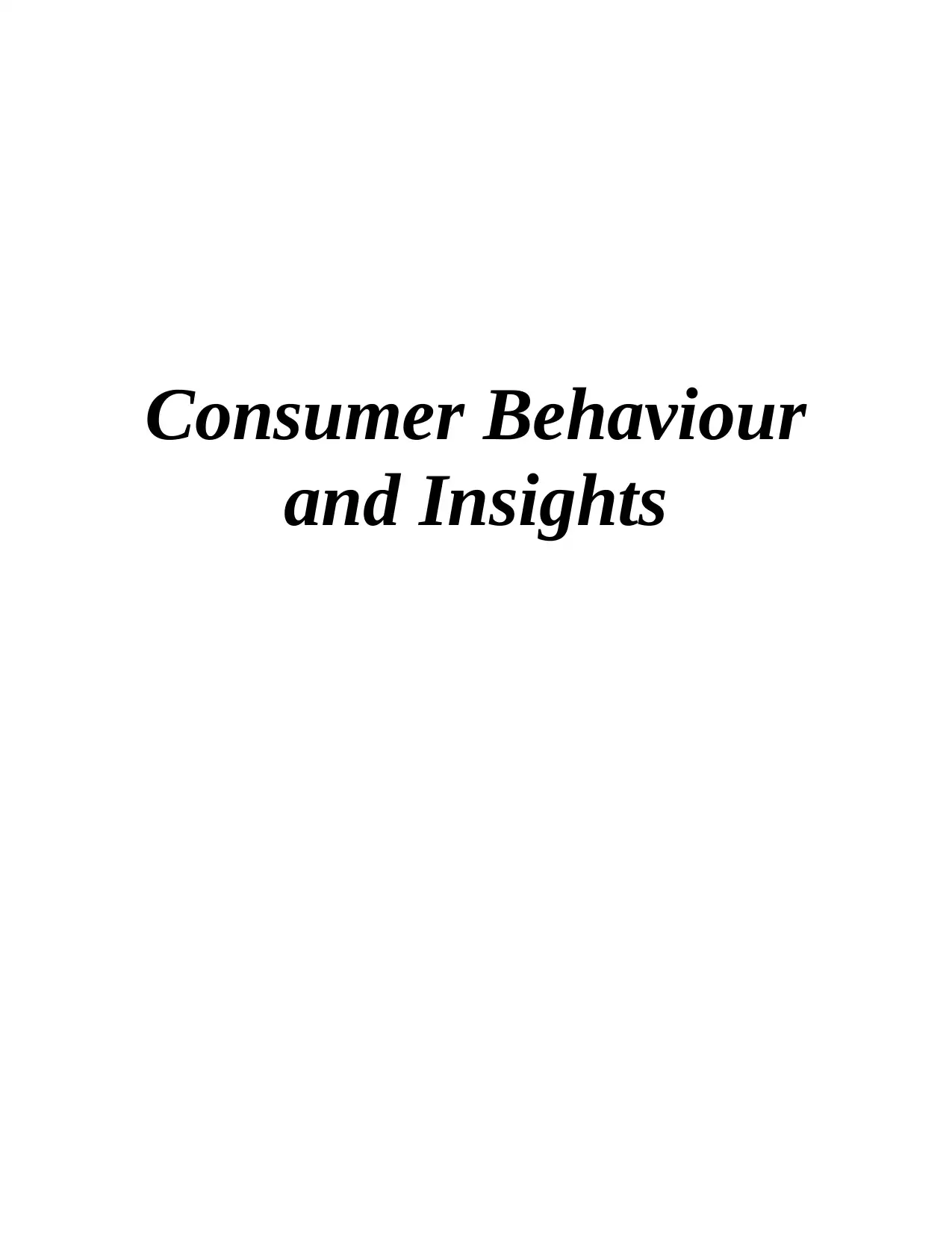
Consumer Behaviour
and Insights
and Insights
Paraphrase This Document
Need a fresh take? Get an instant paraphrase of this document with our AI Paraphraser
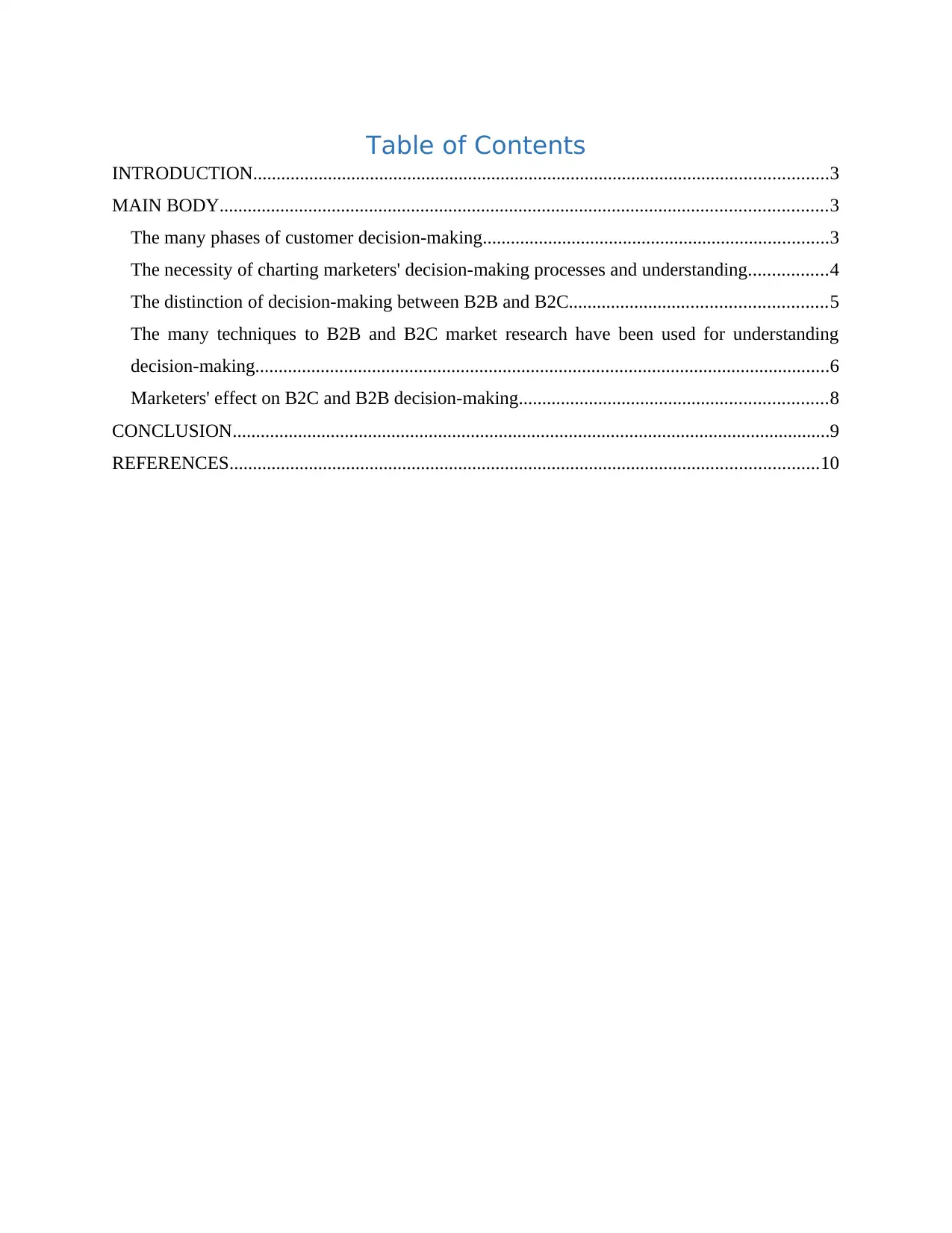
Table of Contents
INTRODUCTION...........................................................................................................................3
MAIN BODY..................................................................................................................................3
The many phases of customer decision-making..........................................................................3
The necessity of charting marketers' decision-making processes and understanding.................4
The distinction of decision-making between B2B and B2C.......................................................5
The many techniques to B2B and B2C market research have been used for understanding
decision-making...........................................................................................................................6
Marketers' effect on B2C and B2B decision-making..................................................................8
CONCLUSION................................................................................................................................9
REFERENCES..............................................................................................................................10
INTRODUCTION...........................................................................................................................3
MAIN BODY..................................................................................................................................3
The many phases of customer decision-making..........................................................................3
The necessity of charting marketers' decision-making processes and understanding.................4
The distinction of decision-making between B2B and B2C.......................................................5
The many techniques to B2B and B2C market research have been used for understanding
decision-making...........................................................................................................................6
Marketers' effect on B2C and B2B decision-making..................................................................8
CONCLUSION................................................................................................................................9
REFERENCES..............................................................................................................................10
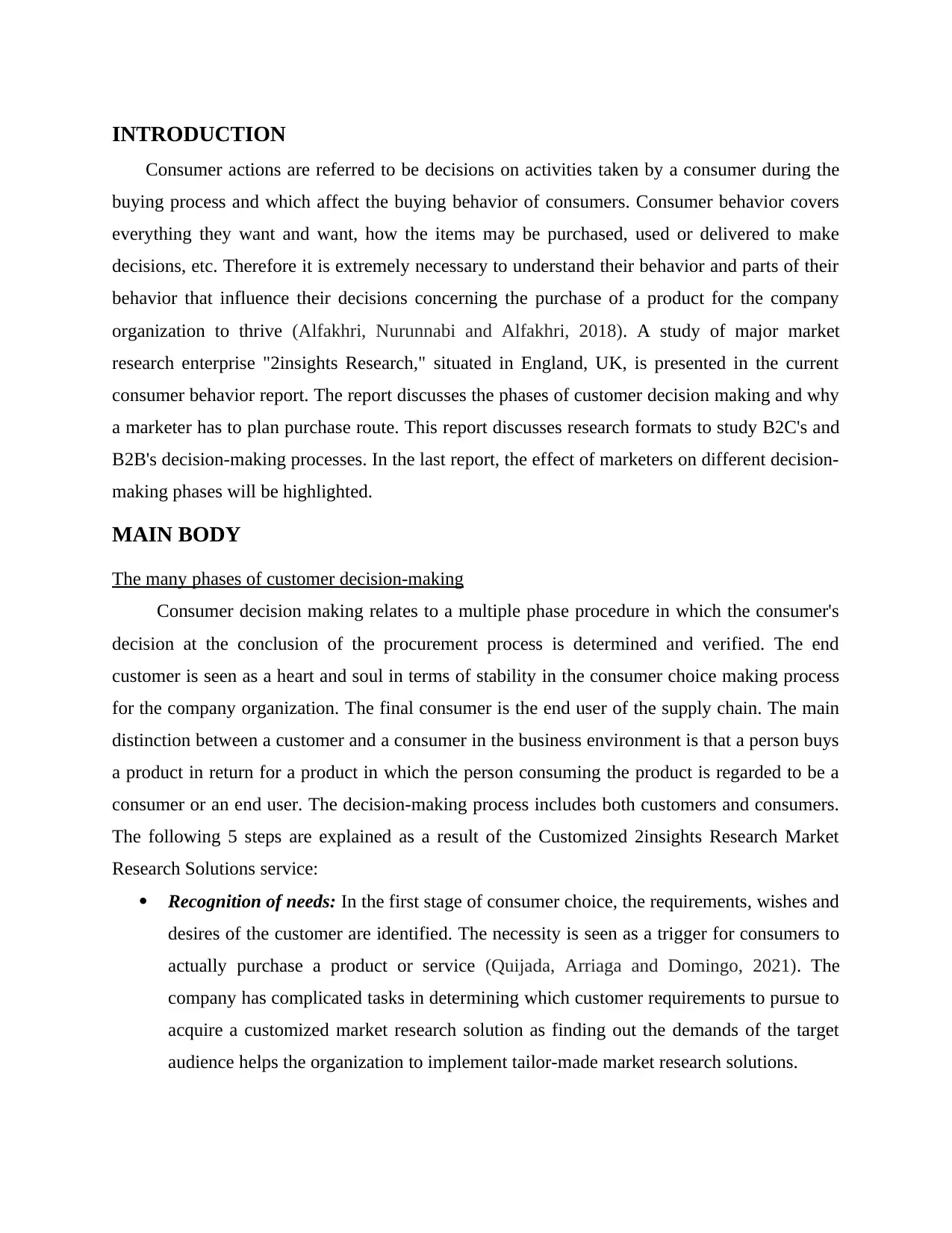
INTRODUCTION
Consumer actions are referred to be decisions on activities taken by a consumer during the
buying process and which affect the buying behavior of consumers. Consumer behavior covers
everything they want and want, how the items may be purchased, used or delivered to make
decisions, etc. Therefore it is extremely necessary to understand their behavior and parts of their
behavior that influence their decisions concerning the purchase of a product for the company
organization to thrive (Alfakhri, Nurunnabi and Alfakhri, 2018). A study of major market
research enterprise "2insights Research," situated in England, UK, is presented in the current
consumer behavior report. The report discusses the phases of customer decision making and why
a marketer has to plan purchase route. This report discusses research formats to study B2C's and
B2B's decision-making processes. In the last report, the effect of marketers on different decision-
making phases will be highlighted.
MAIN BODY
The many phases of customer decision-making
Consumer decision making relates to a multiple phase procedure in which the consumer's
decision at the conclusion of the procurement process is determined and verified. The end
customer is seen as a heart and soul in terms of stability in the consumer choice making process
for the company organization. The final consumer is the end user of the supply chain. The main
distinction between a customer and a consumer in the business environment is that a person buys
a product in return for a product in which the person consuming the product is regarded to be a
consumer or an end user. The decision-making process includes both customers and consumers.
The following 5 steps are explained as a result of the Customized 2insights Research Market
Research Solutions service:
Recognition of needs: In the first stage of consumer choice, the requirements, wishes and
desires of the customer are identified. The necessity is seen as a trigger for consumers to
actually purchase a product or service (Quijada, Arriaga and Domingo, 2021). The
company has complicated tasks in determining which customer requirements to pursue to
acquire a customized market research solution as finding out the demands of the target
audience helps the organization to implement tailor-made market research solutions.
Consumer actions are referred to be decisions on activities taken by a consumer during the
buying process and which affect the buying behavior of consumers. Consumer behavior covers
everything they want and want, how the items may be purchased, used or delivered to make
decisions, etc. Therefore it is extremely necessary to understand their behavior and parts of their
behavior that influence their decisions concerning the purchase of a product for the company
organization to thrive (Alfakhri, Nurunnabi and Alfakhri, 2018). A study of major market
research enterprise "2insights Research," situated in England, UK, is presented in the current
consumer behavior report. The report discusses the phases of customer decision making and why
a marketer has to plan purchase route. This report discusses research formats to study B2C's and
B2B's decision-making processes. In the last report, the effect of marketers on different decision-
making phases will be highlighted.
MAIN BODY
The many phases of customer decision-making
Consumer decision making relates to a multiple phase procedure in which the consumer's
decision at the conclusion of the procurement process is determined and verified. The end
customer is seen as a heart and soul in terms of stability in the consumer choice making process
for the company organization. The final consumer is the end user of the supply chain. The main
distinction between a customer and a consumer in the business environment is that a person buys
a product in return for a product in which the person consuming the product is regarded to be a
consumer or an end user. The decision-making process includes both customers and consumers.
The following 5 steps are explained as a result of the Customized 2insights Research Market
Research Solutions service:
Recognition of needs: In the first stage of consumer choice, the requirements, wishes and
desires of the customer are identified. The necessity is seen as a trigger for consumers to
actually purchase a product or service (Quijada, Arriaga and Domingo, 2021). The
company has complicated tasks in determining which customer requirements to pursue to
acquire a customized market research solution as finding out the demands of the target
audience helps the organization to implement tailor-made market research solutions.
⊘ This is a preview!⊘
Do you want full access?
Subscribe today to unlock all pages.

Trusted by 1+ million students worldwide
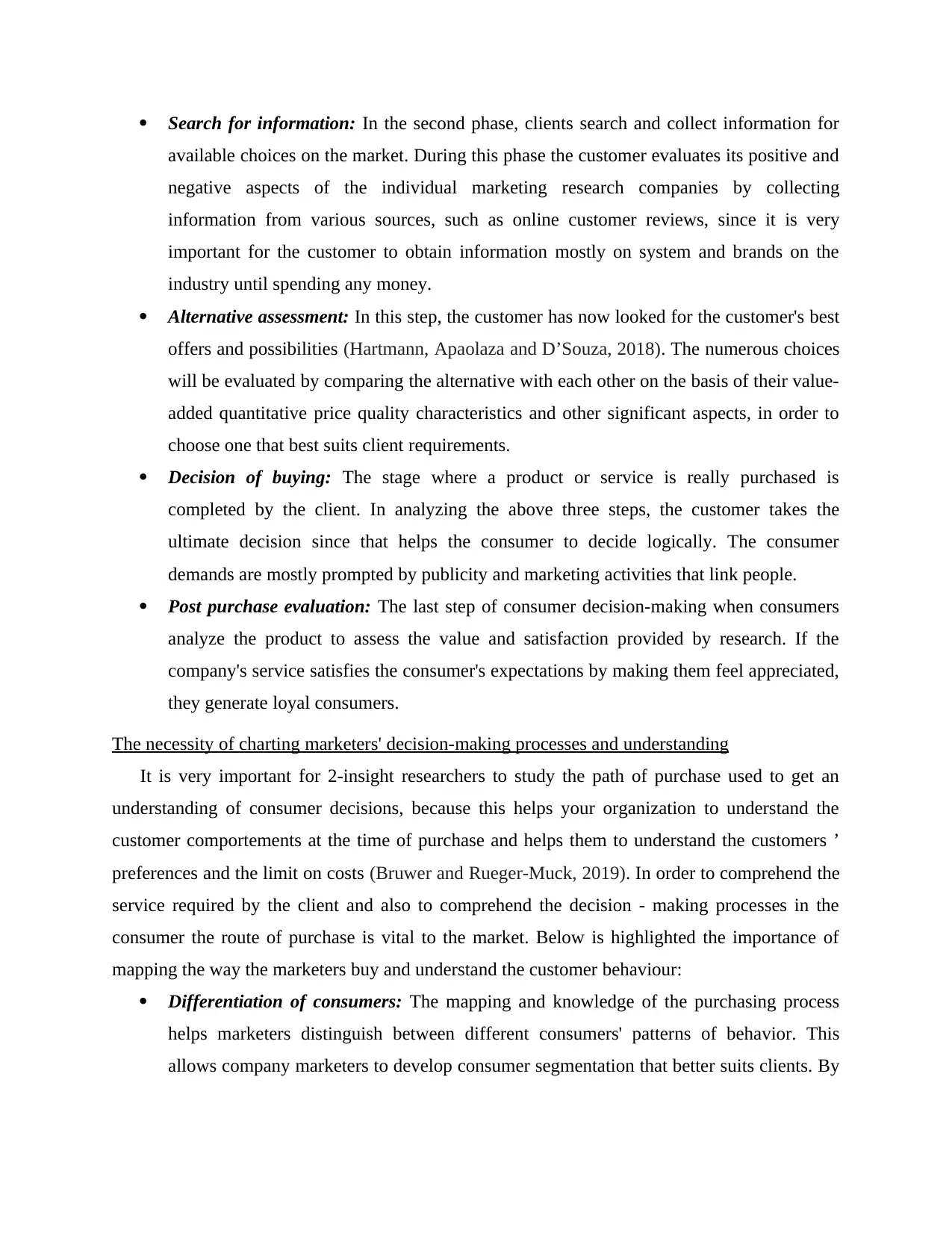
Search for information: In the second phase, clients search and collect information for
available choices on the market. During this phase the customer evaluates its positive and
negative aspects of the individual marketing research companies by collecting
information from various sources, such as online customer reviews, since it is very
important for the customer to obtain information mostly on system and brands on the
industry until spending any money.
Alternative assessment: In this step, the customer has now looked for the customer's best
offers and possibilities (Hartmann, Apaolaza and D’Souza, 2018). The numerous choices
will be evaluated by comparing the alternative with each other on the basis of their value-
added quantitative price quality characteristics and other significant aspects, in order to
choose one that best suits client requirements.
Decision of buying: The stage where a product or service is really purchased is
completed by the client. In analyzing the above three steps, the customer takes the
ultimate decision since that helps the consumer to decide logically. The consumer
demands are mostly prompted by publicity and marketing activities that link people.
Post purchase evaluation: The last step of consumer decision-making when consumers
analyze the product to assess the value and satisfaction provided by research. If the
company's service satisfies the consumer's expectations by making them feel appreciated,
they generate loyal consumers.
The necessity of charting marketers' decision-making processes and understanding
It is very important for 2-insight researchers to study the path of purchase used to get an
understanding of consumer decisions, because this helps your organization to understand the
customer comportements at the time of purchase and helps them to understand the customers ’
preferences and the limit on costs (Bruwer and Rueger-Muck, 2019). In order to comprehend the
service required by the client and also to comprehend the decision - making processes in the
consumer the route of purchase is vital to the market. Below is highlighted the importance of
mapping the way the marketers buy and understand the customer behaviour:
Differentiation of consumers: The mapping and knowledge of the purchasing process
helps marketers distinguish between different consumers' patterns of behavior. This
allows company marketers to develop consumer segmentation that better suits clients. By
available choices on the market. During this phase the customer evaluates its positive and
negative aspects of the individual marketing research companies by collecting
information from various sources, such as online customer reviews, since it is very
important for the customer to obtain information mostly on system and brands on the
industry until spending any money.
Alternative assessment: In this step, the customer has now looked for the customer's best
offers and possibilities (Hartmann, Apaolaza and D’Souza, 2018). The numerous choices
will be evaluated by comparing the alternative with each other on the basis of their value-
added quantitative price quality characteristics and other significant aspects, in order to
choose one that best suits client requirements.
Decision of buying: The stage where a product or service is really purchased is
completed by the client. In analyzing the above three steps, the customer takes the
ultimate decision since that helps the consumer to decide logically. The consumer
demands are mostly prompted by publicity and marketing activities that link people.
Post purchase evaluation: The last step of consumer decision-making when consumers
analyze the product to assess the value and satisfaction provided by research. If the
company's service satisfies the consumer's expectations by making them feel appreciated,
they generate loyal consumers.
The necessity of charting marketers' decision-making processes and understanding
It is very important for 2-insight researchers to study the path of purchase used to get an
understanding of consumer decisions, because this helps your organization to understand the
customer comportements at the time of purchase and helps them to understand the customers ’
preferences and the limit on costs (Bruwer and Rueger-Muck, 2019). In order to comprehend the
service required by the client and also to comprehend the decision - making processes in the
consumer the route of purchase is vital to the market. Below is highlighted the importance of
mapping the way the marketers buy and understand the customer behaviour:
Differentiation of consumers: The mapping and knowledge of the purchasing process
helps marketers distinguish between different consumers' patterns of behavior. This
allows company marketers to develop consumer segmentation that better suits clients. By
Paraphrase This Document
Need a fresh take? Get an instant paraphrase of this document with our AI Paraphraser
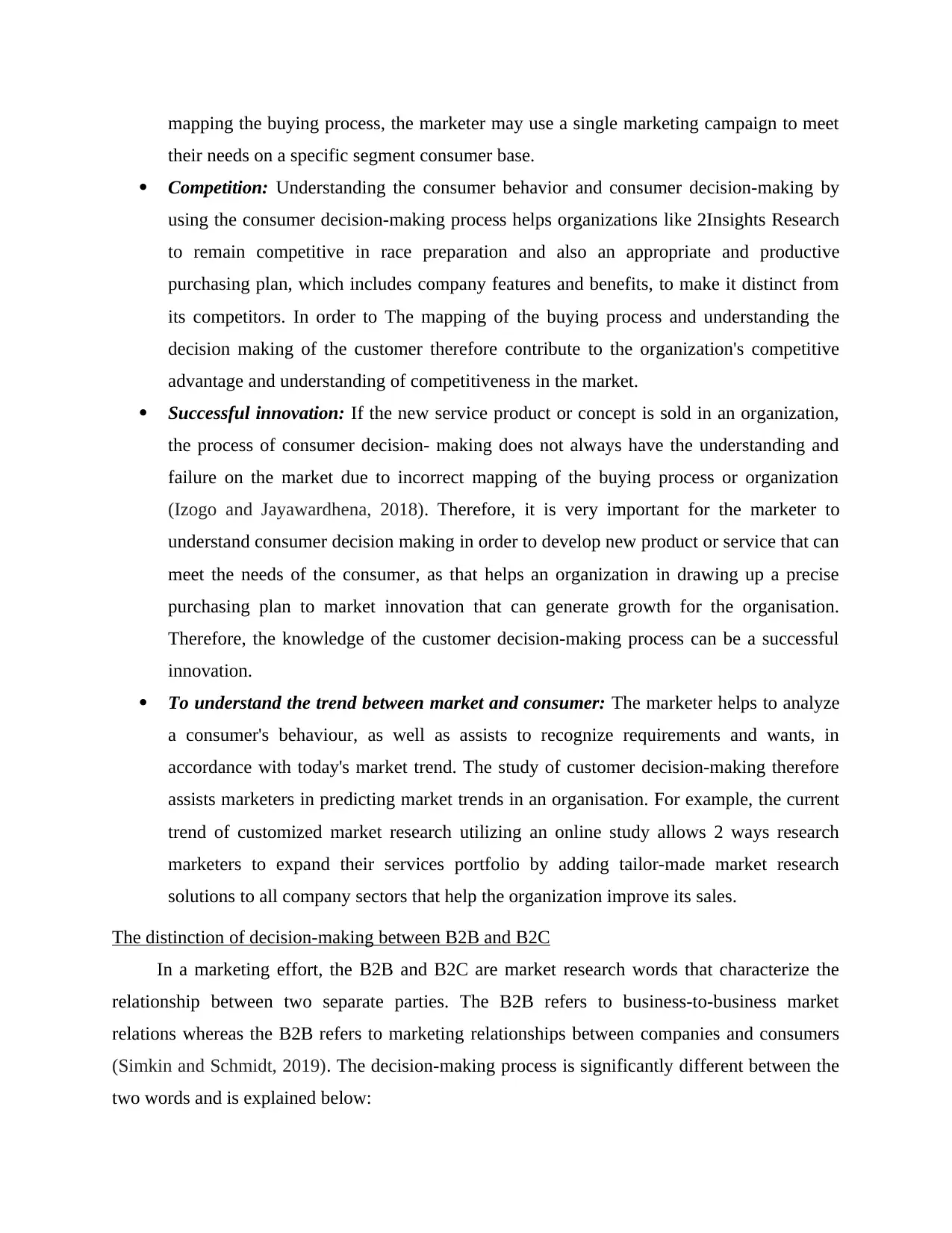
mapping the buying process, the marketer may use a single marketing campaign to meet
their needs on a specific segment consumer base.
Competition: Understanding the consumer behavior and consumer decision-making by
using the consumer decision-making process helps organizations like 2Insights Research
to remain competitive in race preparation and also an appropriate and productive
purchasing plan, which includes company features and benefits, to make it distinct from
its competitors. In order to The mapping of the buying process and understanding the
decision making of the customer therefore contribute to the organization's competitive
advantage and understanding of competitiveness in the market.
Successful innovation: If the new service product or concept is sold in an organization,
the process of consumer decision- making does not always have the understanding and
failure on the market due to incorrect mapping of the buying process or organization
(Izogo and Jayawardhena, 2018). Therefore, it is very important for the marketer to
understand consumer decision making in order to develop new product or service that can
meet the needs of the consumer, as that helps an organization in drawing up a precise
purchasing plan to market innovation that can generate growth for the organisation.
Therefore, the knowledge of the customer decision-making process can be a successful
innovation.
To understand the trend between market and consumer: The marketer helps to analyze
a consumer's behaviour, as well as assists to recognize requirements and wants, in
accordance with today's market trend. The study of customer decision-making therefore
assists marketers in predicting market trends in an organisation. For example, the current
trend of customized market research utilizing an online study allows 2 ways research
marketers to expand their services portfolio by adding tailor-made market research
solutions to all company sectors that help the organization improve its sales.
The distinction of decision-making between B2B and B2C
In a marketing effort, the B2B and B2C are market research words that characterize the
relationship between two separate parties. The B2B refers to business-to-business market
relations whereas the B2B refers to marketing relationships between companies and consumers
(Simkin and Schmidt, 2019). The decision-making process is significantly different between the
two words and is explained below:
their needs on a specific segment consumer base.
Competition: Understanding the consumer behavior and consumer decision-making by
using the consumer decision-making process helps organizations like 2Insights Research
to remain competitive in race preparation and also an appropriate and productive
purchasing plan, which includes company features and benefits, to make it distinct from
its competitors. In order to The mapping of the buying process and understanding the
decision making of the customer therefore contribute to the organization's competitive
advantage and understanding of competitiveness in the market.
Successful innovation: If the new service product or concept is sold in an organization,
the process of consumer decision- making does not always have the understanding and
failure on the market due to incorrect mapping of the buying process or organization
(Izogo and Jayawardhena, 2018). Therefore, it is very important for the marketer to
understand consumer decision making in order to develop new product or service that can
meet the needs of the consumer, as that helps an organization in drawing up a precise
purchasing plan to market innovation that can generate growth for the organisation.
Therefore, the knowledge of the customer decision-making process can be a successful
innovation.
To understand the trend between market and consumer: The marketer helps to analyze
a consumer's behaviour, as well as assists to recognize requirements and wants, in
accordance with today's market trend. The study of customer decision-making therefore
assists marketers in predicting market trends in an organisation. For example, the current
trend of customized market research utilizing an online study allows 2 ways research
marketers to expand their services portfolio by adding tailor-made market research
solutions to all company sectors that help the organization improve its sales.
The distinction of decision-making between B2B and B2C
In a marketing effort, the B2B and B2C are market research words that characterize the
relationship between two separate parties. The B2B refers to business-to-business market
relations whereas the B2B refers to marketing relationships between companies and consumers
(Simkin and Schmidt, 2019). The decision-making process is significantly different between the
two words and is explained below:
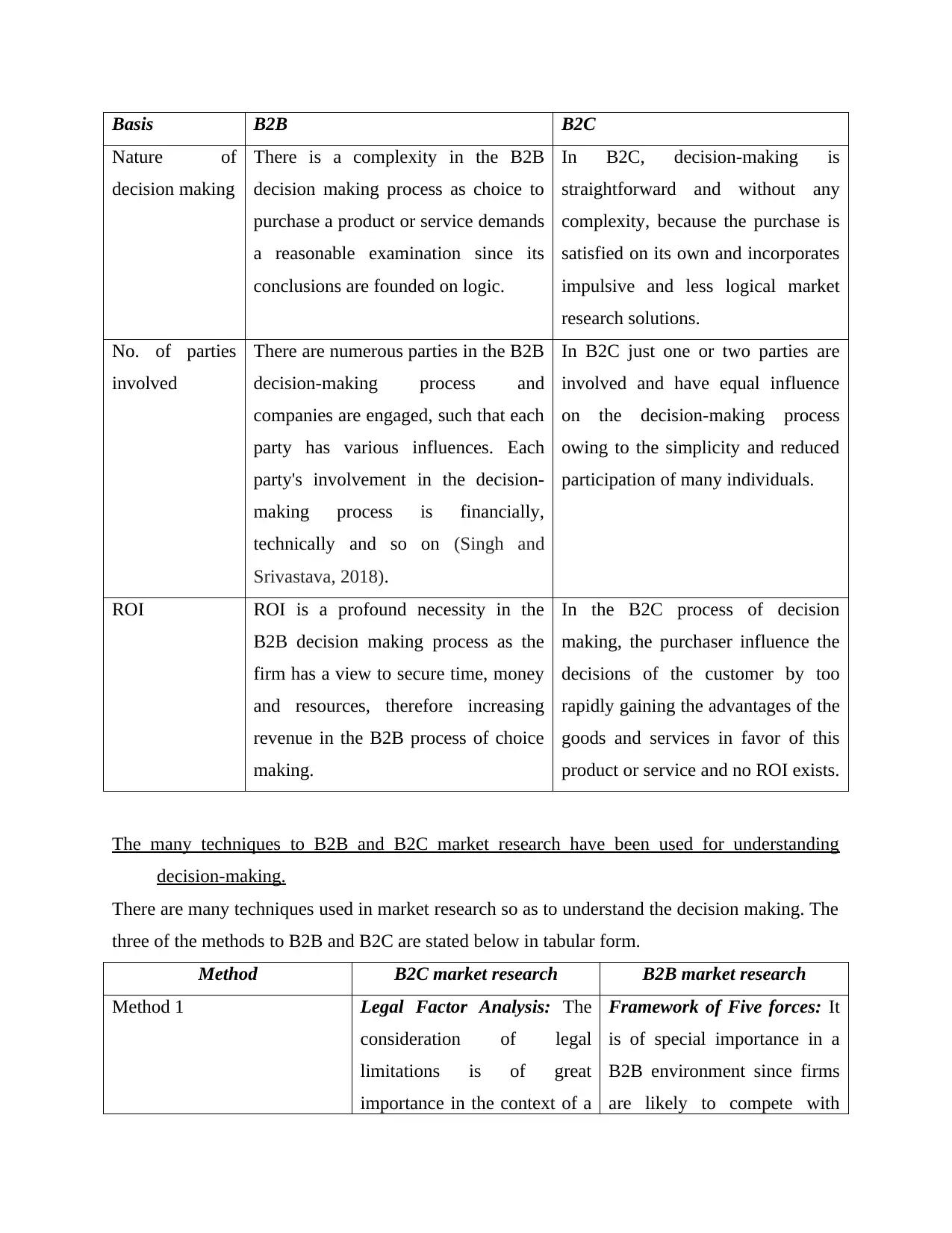
Basis B2B B2C
Nature of
decision making
There is a complexity in the B2B
decision making process as choice to
purchase a product or service demands
a reasonable examination since its
conclusions are founded on logic.
In B2C, decision-making is
straightforward and without any
complexity, because the purchase is
satisfied on its own and incorporates
impulsive and less logical market
research solutions.
No. of parties
involved
There are numerous parties in the B2B
decision-making process and
companies are engaged, such that each
party has various influences. Each
party's involvement in the decision-
making process is financially,
technically and so on (Singh and
Srivastava, 2018).
In B2C just one or two parties are
involved and have equal influence
on the decision-making process
owing to the simplicity and reduced
participation of many individuals.
ROI ROI is a profound necessity in the
B2B decision making process as the
firm has a view to secure time, money
and resources, therefore increasing
revenue in the B2B process of choice
making.
In the B2C process of decision
making, the purchaser influence the
decisions of the customer by too
rapidly gaining the advantages of the
goods and services in favor of this
product or service and no ROI exists.
The many techniques to B2B and B2C market research have been used for understanding
decision-making.
There are many techniques used in market research so as to understand the decision making. The
three of the methods to B2B and B2C are stated below in tabular form.
Method B2C market research B2B market research
Method 1 Legal Factor Analysis: The
consideration of legal
limitations is of great
importance in the context of a
Framework of Five forces: It
is of special importance in a
B2B environment since firms
are likely to compete with
Nature of
decision making
There is a complexity in the B2B
decision making process as choice to
purchase a product or service demands
a reasonable examination since its
conclusions are founded on logic.
In B2C, decision-making is
straightforward and without any
complexity, because the purchase is
satisfied on its own and incorporates
impulsive and less logical market
research solutions.
No. of parties
involved
There are numerous parties in the B2B
decision-making process and
companies are engaged, such that each
party has various influences. Each
party's involvement in the decision-
making process is financially,
technically and so on (Singh and
Srivastava, 2018).
In B2C just one or two parties are
involved and have equal influence
on the decision-making process
owing to the simplicity and reduced
participation of many individuals.
ROI ROI is a profound necessity in the
B2B decision making process as the
firm has a view to secure time, money
and resources, therefore increasing
revenue in the B2B process of choice
making.
In the B2C process of decision
making, the purchaser influence the
decisions of the customer by too
rapidly gaining the advantages of the
goods and services in favor of this
product or service and no ROI exists.
The many techniques to B2B and B2C market research have been used for understanding
decision-making.
There are many techniques used in market research so as to understand the decision making. The
three of the methods to B2B and B2C are stated below in tabular form.
Method B2C market research B2B market research
Method 1 Legal Factor Analysis: The
consideration of legal
limitations is of great
importance in the context of a
Framework of Five forces: It
is of special importance in a
B2B environment since firms
are likely to compete with
⊘ This is a preview!⊘
Do you want full access?
Subscribe today to unlock all pages.

Trusted by 1+ million students worldwide
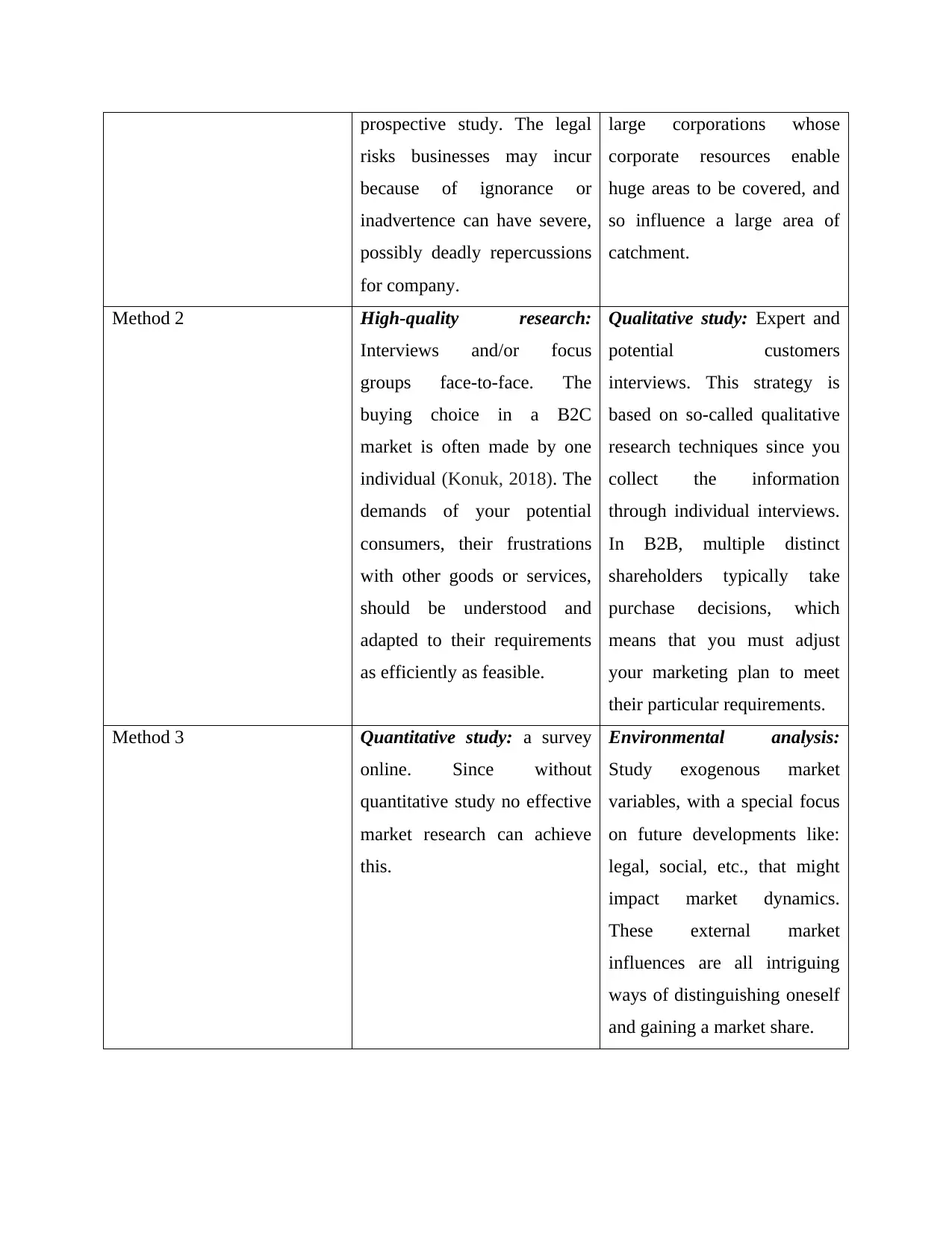
prospective study. The legal
risks businesses may incur
because of ignorance or
inadvertence can have severe,
possibly deadly repercussions
for company.
large corporations whose
corporate resources enable
huge areas to be covered, and
so influence a large area of
catchment.
Method 2 High-quality research:
Interviews and/or focus
groups face-to-face. The
buying choice in a B2C
market is often made by one
individual (Konuk, 2018). The
demands of your potential
consumers, their frustrations
with other goods or services,
should be understood and
adapted to their requirements
as efficiently as feasible.
Qualitative study: Expert and
potential customers
interviews. This strategy is
based on so-called qualitative
research techniques since you
collect the information
through individual interviews.
In B2B, multiple distinct
shareholders typically take
purchase decisions, which
means that you must adjust
your marketing plan to meet
their particular requirements.
Method 3 Quantitative study: a survey
online. Since without
quantitative study no effective
market research can achieve
this.
Environmental analysis:
Study exogenous market
variables, with a special focus
on future developments like:
legal, social, etc., that might
impact market dynamics.
These external market
influences are all intriguing
ways of distinguishing oneself
and gaining a market share.
risks businesses may incur
because of ignorance or
inadvertence can have severe,
possibly deadly repercussions
for company.
large corporations whose
corporate resources enable
huge areas to be covered, and
so influence a large area of
catchment.
Method 2 High-quality research:
Interviews and/or focus
groups face-to-face. The
buying choice in a B2C
market is often made by one
individual (Konuk, 2018). The
demands of your potential
consumers, their frustrations
with other goods or services,
should be understood and
adapted to their requirements
as efficiently as feasible.
Qualitative study: Expert and
potential customers
interviews. This strategy is
based on so-called qualitative
research techniques since you
collect the information
through individual interviews.
In B2B, multiple distinct
shareholders typically take
purchase decisions, which
means that you must adjust
your marketing plan to meet
their particular requirements.
Method 3 Quantitative study: a survey
online. Since without
quantitative study no effective
market research can achieve
this.
Environmental analysis:
Study exogenous market
variables, with a special focus
on future developments like:
legal, social, etc., that might
impact market dynamics.
These external market
influences are all intriguing
ways of distinguishing oneself
and gaining a market share.
Paraphrase This Document
Need a fresh take? Get an instant paraphrase of this document with our AI Paraphraser
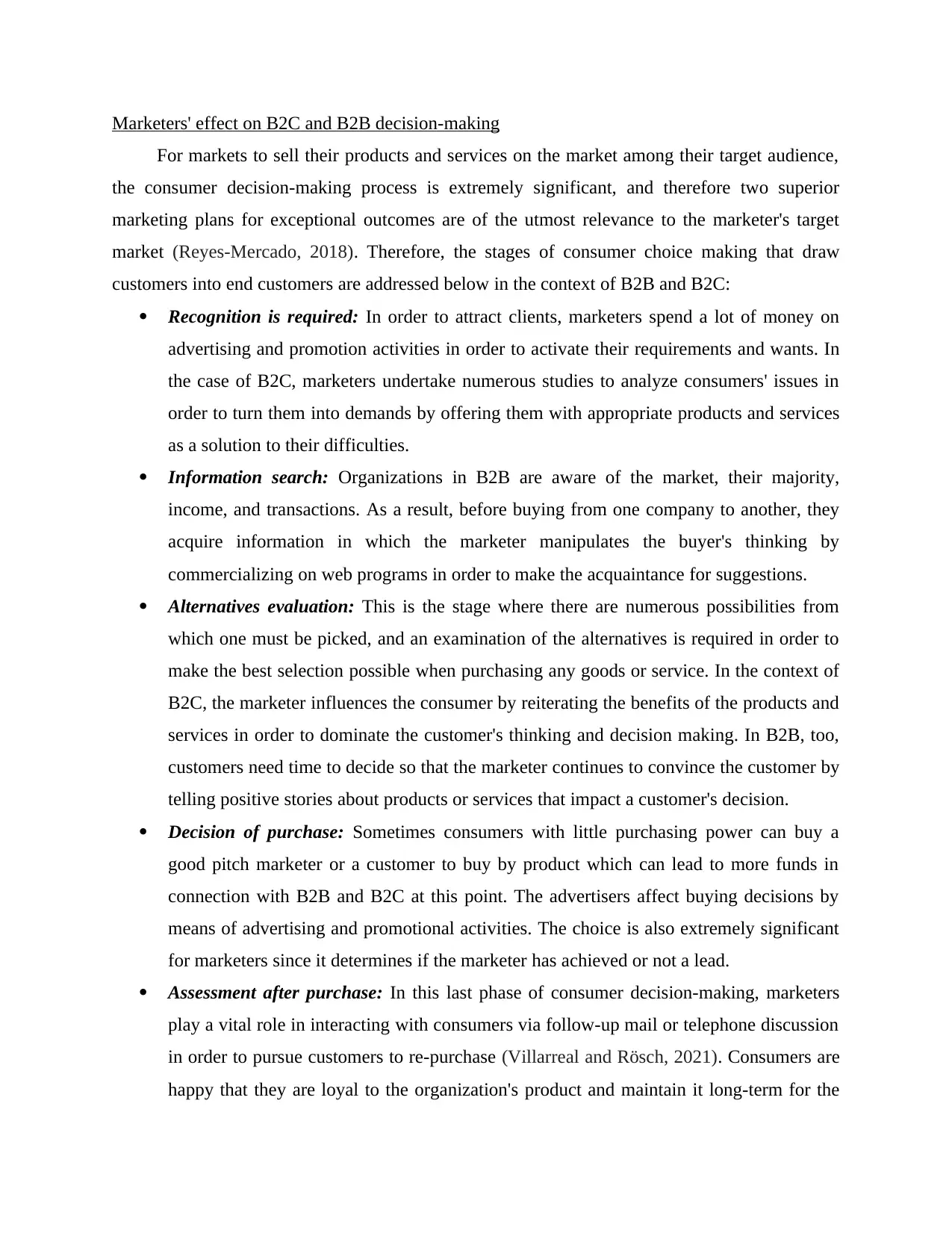
Marketers' effect on B2C and B2B decision-making
For markets to sell their products and services on the market among their target audience,
the consumer decision-making process is extremely significant, and therefore two superior
marketing plans for exceptional outcomes are of the utmost relevance to the marketer's target
market (Reyes-Mercado, 2018). Therefore, the stages of consumer choice making that draw
customers into end customers are addressed below in the context of B2B and B2C:
Recognition is required: In order to attract clients, marketers spend a lot of money on
advertising and promotion activities in order to activate their requirements and wants. In
the case of B2C, marketers undertake numerous studies to analyze consumers' issues in
order to turn them into demands by offering them with appropriate products and services
as a solution to their difficulties.
Information search: Organizations in B2B are aware of the market, their majority,
income, and transactions. As a result, before buying from one company to another, they
acquire information in which the marketer manipulates the buyer's thinking by
commercializing on web programs in order to make the acquaintance for suggestions.
Alternatives evaluation: This is the stage where there are numerous possibilities from
which one must be picked, and an examination of the alternatives is required in order to
make the best selection possible when purchasing any goods or service. In the context of
B2C, the marketer influences the consumer by reiterating the benefits of the products and
services in order to dominate the customer's thinking and decision making. In B2B, too,
customers need time to decide so that the marketer continues to convince the customer by
telling positive stories about products or services that impact a customer's decision.
Decision of purchase: Sometimes consumers with little purchasing power can buy a
good pitch marketer or a customer to buy by product which can lead to more funds in
connection with B2B and B2C at this point. The advertisers affect buying decisions by
means of advertising and promotional activities. The choice is also extremely significant
for marketers since it determines if the marketer has achieved or not a lead.
Assessment after purchase: In this last phase of consumer decision-making, marketers
play a vital role in interacting with consumers via follow-up mail or telephone discussion
in order to pursue customers to re-purchase (Villarreal and Rösch, 2021). Consumers are
happy that they are loyal to the organization's product and maintain it long-term for the
For markets to sell their products and services on the market among their target audience,
the consumer decision-making process is extremely significant, and therefore two superior
marketing plans for exceptional outcomes are of the utmost relevance to the marketer's target
market (Reyes-Mercado, 2018). Therefore, the stages of consumer choice making that draw
customers into end customers are addressed below in the context of B2B and B2C:
Recognition is required: In order to attract clients, marketers spend a lot of money on
advertising and promotion activities in order to activate their requirements and wants. In
the case of B2C, marketers undertake numerous studies to analyze consumers' issues in
order to turn them into demands by offering them with appropriate products and services
as a solution to their difficulties.
Information search: Organizations in B2B are aware of the market, their majority,
income, and transactions. As a result, before buying from one company to another, they
acquire information in which the marketer manipulates the buyer's thinking by
commercializing on web programs in order to make the acquaintance for suggestions.
Alternatives evaluation: This is the stage where there are numerous possibilities from
which one must be picked, and an examination of the alternatives is required in order to
make the best selection possible when purchasing any goods or service. In the context of
B2C, the marketer influences the consumer by reiterating the benefits of the products and
services in order to dominate the customer's thinking and decision making. In B2B, too,
customers need time to decide so that the marketer continues to convince the customer by
telling positive stories about products or services that impact a customer's decision.
Decision of purchase: Sometimes consumers with little purchasing power can buy a
good pitch marketer or a customer to buy by product which can lead to more funds in
connection with B2B and B2C at this point. The advertisers affect buying decisions by
means of advertising and promotional activities. The choice is also extremely significant
for marketers since it determines if the marketer has achieved or not a lead.
Assessment after purchase: In this last phase of consumer decision-making, marketers
play a vital role in interacting with consumers via follow-up mail or telephone discussion
in order to pursue customers to re-purchase (Villarreal and Rösch, 2021). Consumers are
happy that they are loyal to the organization's product and maintain it long-term for the
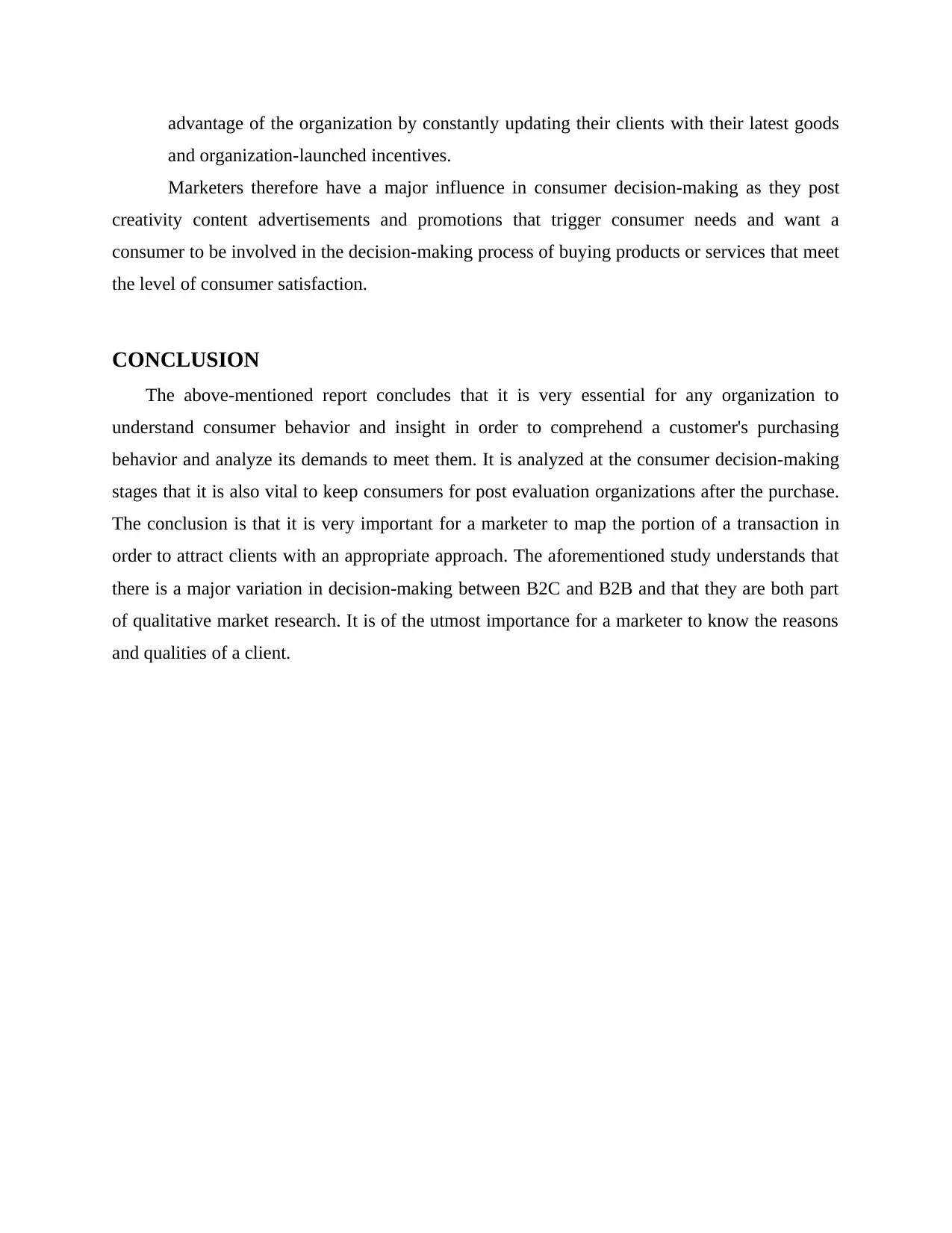
advantage of the organization by constantly updating their clients with their latest goods
and organization-launched incentives.
Marketers therefore have a major influence in consumer decision-making as they post
creativity content advertisements and promotions that trigger consumer needs and want a
consumer to be involved in the decision-making process of buying products or services that meet
the level of consumer satisfaction.
CONCLUSION
The above-mentioned report concludes that it is very essential for any organization to
understand consumer behavior and insight in order to comprehend a customer's purchasing
behavior and analyze its demands to meet them. It is analyzed at the consumer decision-making
stages that it is also vital to keep consumers for post evaluation organizations after the purchase.
The conclusion is that it is very important for a marketer to map the portion of a transaction in
order to attract clients with an appropriate approach. The aforementioned study understands that
there is a major variation in decision-making between B2C and B2B and that they are both part
of qualitative market research. It is of the utmost importance for a marketer to know the reasons
and qualities of a client.
and organization-launched incentives.
Marketers therefore have a major influence in consumer decision-making as they post
creativity content advertisements and promotions that trigger consumer needs and want a
consumer to be involved in the decision-making process of buying products or services that meet
the level of consumer satisfaction.
CONCLUSION
The above-mentioned report concludes that it is very essential for any organization to
understand consumer behavior and insight in order to comprehend a customer's purchasing
behavior and analyze its demands to meet them. It is analyzed at the consumer decision-making
stages that it is also vital to keep consumers for post evaluation organizations after the purchase.
The conclusion is that it is very important for a marketer to map the portion of a transaction in
order to attract clients with an appropriate approach. The aforementioned study understands that
there is a major variation in decision-making between B2C and B2B and that they are both part
of qualitative market research. It is of the utmost importance for a marketer to know the reasons
and qualities of a client.
⊘ This is a preview!⊘
Do you want full access?
Subscribe today to unlock all pages.

Trusted by 1+ million students worldwide
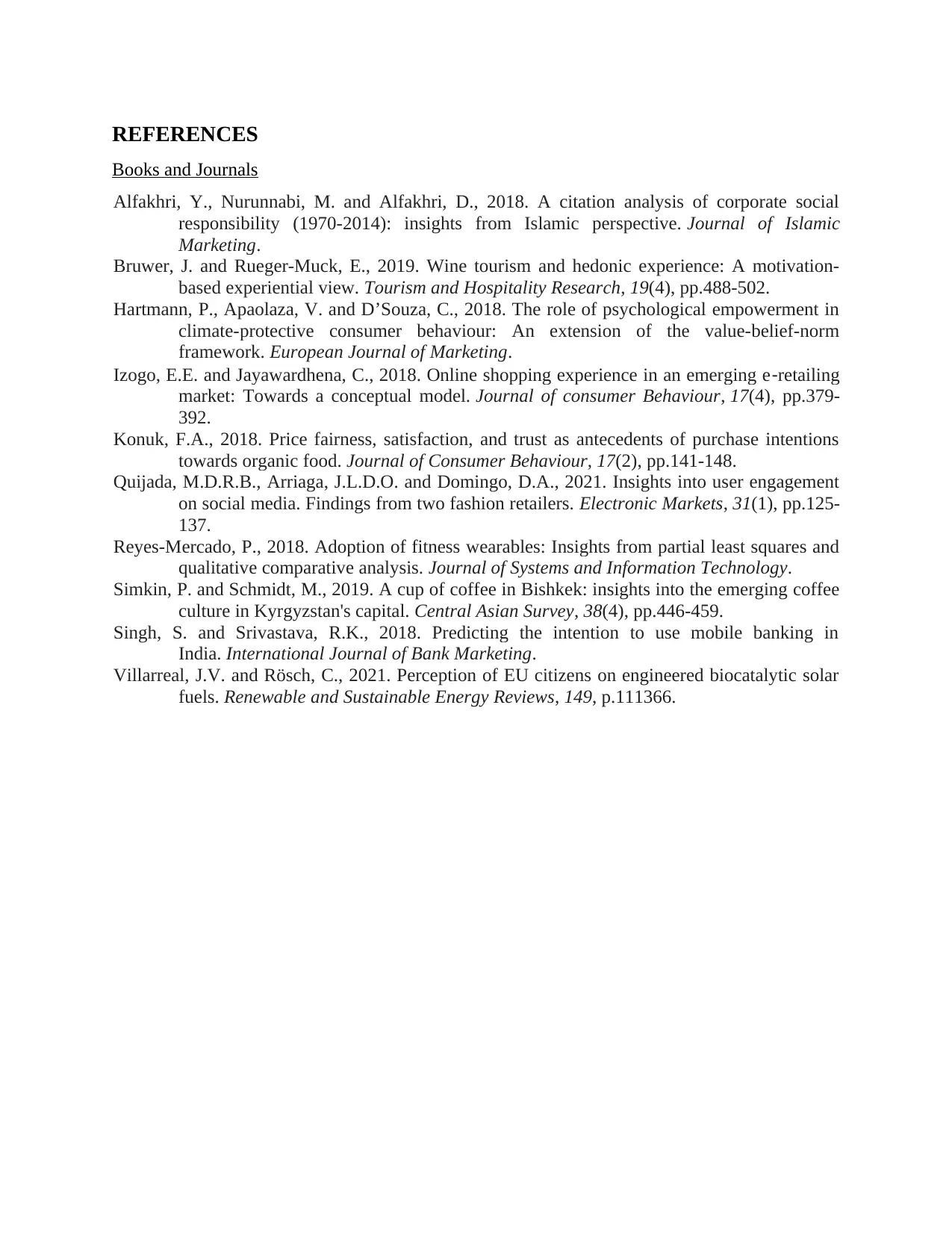
REFERENCES
Books and Journals
Alfakhri, Y., Nurunnabi, M. and Alfakhri, D., 2018. A citation analysis of corporate social
responsibility (1970-2014): insights from Islamic perspective. Journal of Islamic
Marketing.
Bruwer, J. and Rueger-Muck, E., 2019. Wine tourism and hedonic experience: A motivation-
based experiential view. Tourism and Hospitality Research, 19(4), pp.488-502.
Hartmann, P., Apaolaza, V. and D’Souza, C., 2018. The role of psychological empowerment in
climate-protective consumer behaviour: An extension of the value-belief-norm
framework. European Journal of Marketing.
Izogo, E.E. and Jayawardhena, C., 2018. Online shopping experience in an emerging e‐retailing
market: Towards a conceptual model. Journal of consumer Behaviour, 17(4), pp.379-
392.
Konuk, F.A., 2018. Price fairness, satisfaction, and trust as antecedents of purchase intentions
towards organic food. Journal of Consumer Behaviour, 17(2), pp.141-148.
Quijada, M.D.R.B., Arriaga, J.L.D.O. and Domingo, D.A., 2021. Insights into user engagement
on social media. Findings from two fashion retailers. Electronic Markets, 31(1), pp.125-
137.
Reyes-Mercado, P., 2018. Adoption of fitness wearables: Insights from partial least squares and
qualitative comparative analysis. Journal of Systems and Information Technology.
Simkin, P. and Schmidt, M., 2019. A cup of coffee in Bishkek: insights into the emerging coffee
culture in Kyrgyzstan's capital. Central Asian Survey, 38(4), pp.446-459.
Singh, S. and Srivastava, R.K., 2018. Predicting the intention to use mobile banking in
India. International Journal of Bank Marketing.
Villarreal, J.V. and Rösch, C., 2021. Perception of EU citizens on engineered biocatalytic solar
fuels. Renewable and Sustainable Energy Reviews, 149, p.111366.
Books and Journals
Alfakhri, Y., Nurunnabi, M. and Alfakhri, D., 2018. A citation analysis of corporate social
responsibility (1970-2014): insights from Islamic perspective. Journal of Islamic
Marketing.
Bruwer, J. and Rueger-Muck, E., 2019. Wine tourism and hedonic experience: A motivation-
based experiential view. Tourism and Hospitality Research, 19(4), pp.488-502.
Hartmann, P., Apaolaza, V. and D’Souza, C., 2018. The role of psychological empowerment in
climate-protective consumer behaviour: An extension of the value-belief-norm
framework. European Journal of Marketing.
Izogo, E.E. and Jayawardhena, C., 2018. Online shopping experience in an emerging e‐retailing
market: Towards a conceptual model. Journal of consumer Behaviour, 17(4), pp.379-
392.
Konuk, F.A., 2018. Price fairness, satisfaction, and trust as antecedents of purchase intentions
towards organic food. Journal of Consumer Behaviour, 17(2), pp.141-148.
Quijada, M.D.R.B., Arriaga, J.L.D.O. and Domingo, D.A., 2021. Insights into user engagement
on social media. Findings from two fashion retailers. Electronic Markets, 31(1), pp.125-
137.
Reyes-Mercado, P., 2018. Adoption of fitness wearables: Insights from partial least squares and
qualitative comparative analysis. Journal of Systems and Information Technology.
Simkin, P. and Schmidt, M., 2019. A cup of coffee in Bishkek: insights into the emerging coffee
culture in Kyrgyzstan's capital. Central Asian Survey, 38(4), pp.446-459.
Singh, S. and Srivastava, R.K., 2018. Predicting the intention to use mobile banking in
India. International Journal of Bank Marketing.
Villarreal, J.V. and Rösch, C., 2021. Perception of EU citizens on engineered biocatalytic solar
fuels. Renewable and Sustainable Energy Reviews, 149, p.111366.
1 out of 10
Related Documents
Your All-in-One AI-Powered Toolkit for Academic Success.
+13062052269
info@desklib.com
Available 24*7 on WhatsApp / Email
![[object Object]](/_next/static/media/star-bottom.7253800d.svg)
Unlock your academic potential
Copyright © 2020–2025 A2Z Services. All Rights Reserved. Developed and managed by ZUCOL.




